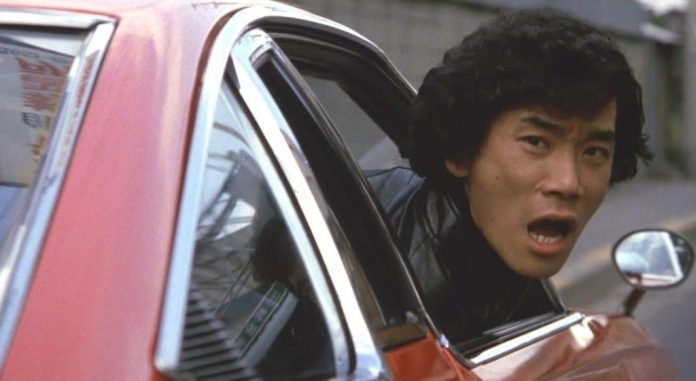
If you go on google maps and zoom in on the Harima-cho intersection in Osaka’s Sumiyoshi Ward, on the southwest corner of the intersection the Kitabatake Branch of MUFG Bank will show up. Click on the icon and go straight to the comments. Besides of the usual tripe concerning the current customer service, references rather unusual for a Japanese bank quickly pop up.
One commenter writes, “About 40 years ago, there was a bank robbery at Mitsubishi Bank Kitabatake branch. Umekawa was the culprit and it’s a pretty big case. I was in the first grade of elementary school at the time, and I remember it well.” Another one adds, “In 1979, there was a barricaded incident in which 4 people died and 5 people were injured. The culprit was shot when the police force broke through, and died of the loss of a large amount of blood on the same day. The building is now new, but the location is the same as it was at the time of the incident.”
Indeed, one of the most spectacular bank robberies in Japanese history took place at that location, then still called Mitsubishi Bank. On January 26th 1979, a man named Akiyoshi Umekawa entered the bank carrying a rifle. He shot dead two bank employees and took about 40 customers hostage.
During the following 42-hour stand-off, Umekawa shot dead two policemen, he forced some of the female hostages to strip naked and form a human shield around him, he randomly shot at the walls to terrorize his hostages, inflicting serious injuries on some of them by bullets ricocheting.
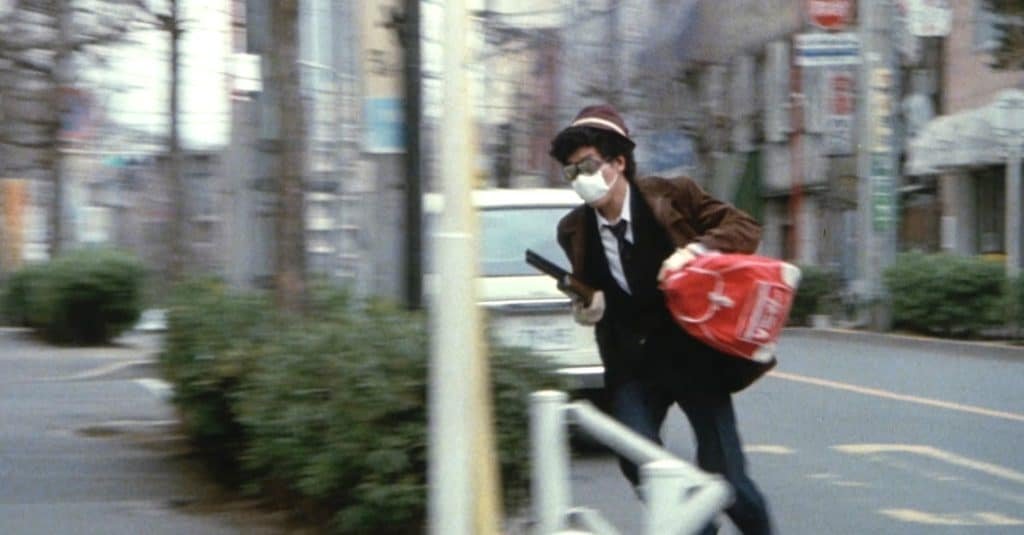
All the while, he regaled his hostages with movie references. Umekawa was obsessed with Pier Paolo Pasolini’s 1976 film Salò, or the 120 Days of Sodom, known in Japan as Sodom no Ichi. The film, based on a late 18th century book by the Marquis de Sade, depicts the extreme sexual torture a four-men group inflicts on their many victims while holed up in an Italian castle in the final days of World War II. In a way, it seemed, Umekawa wanted to recreate the story told in the film on his own terms – right in the middle of Osaka.
Police tried to defuse the situation via negotiations but Umekawa refused all talks. Eventually, police used deadly force. A commando squad broke into the bank and shot Umekawa. He died the same day.
Press coverage of the incident was intense. Journalists delved into every aspect of the life of the Umekawa, hailing from Hiroshima Prefecture but having partly grown up in Kagawa Prefecture, Shikoku.
As a 15-year-old, it turned out, Umekawa had robbed the office of the construction company where he did part-time work, killing a young woman in the process.
Umekawa was sent to youth prison and released after about 5 years. Because Umekawa was a minor at the time of the murder, his records were sealed. Thus, he was able to buy guns legally later on.
Table of Contents
Tattoo Ari (Japan, 1982) TATTOO<刺青>あり
The 1982 film Tattoo Ari starts on the premise that audiences are already familiar with the robbery case at the Mitsubishi Bank in Harima-cho. The case had dominated the press for months, it had been featured in endless TV re-enactments.
Rather than going for another re-enactment of the actual bank robbery / hostage standoff, director Banmei Takahashi opted for omitting the actual crime altogether and focus on the developments that lead Umekawa to commit his crime.
Thus, the film is a psychological drama rather than a shoot-out action flick.
It starts with 15-year old Akio Takeda (a fictionalized name for Akiyoshi Umekawa) murdering a young woman in the course of a robbery in a small town in Hiroshima Prefecture.
Then, the movie jumps to Takeda’s 20th birthday, by then played by Japanese rock star Ryudo Uzaki His probation officer has his final talk with Takeda before Takeda sets out for the big city: Osaka.
Having sworn to himself that by the age of 30, he will have made it big time, Takeda enters city life. He gets a tattoo of a peony flower on his right upper chest and, corresponding to it, a dragon on his left shoulder. A powerful pair of symbols indicating strength in the world of the yakuza. Just that Takeda doesn’t belong to any yakuza group. In his case, it’s all just for show. Takeda often opens the buttons of his shirt, just to intimidate people. Saying “See that?”, when pointing out the tattoo.
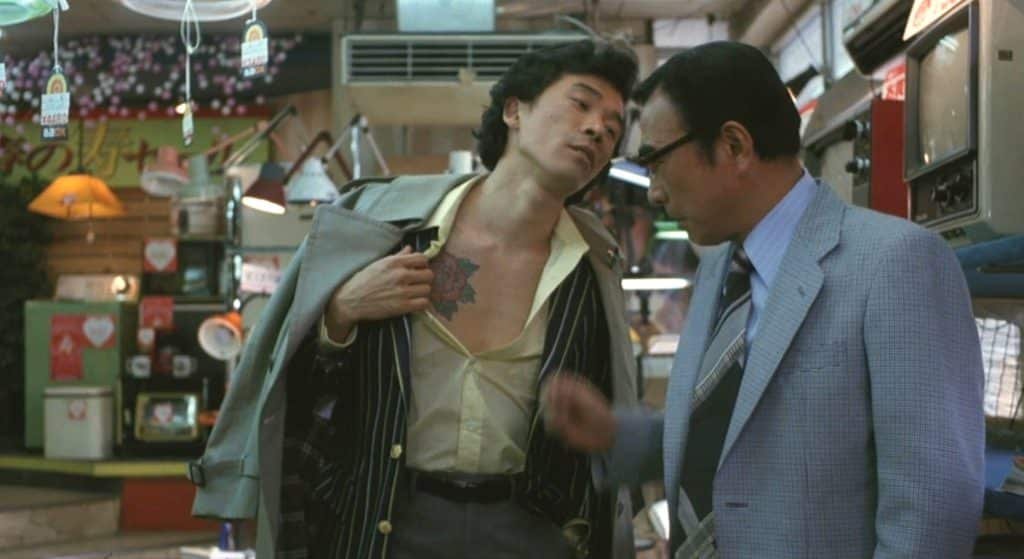
Just for show is also the bad guy rock’n’roll perm he acquires, fashionable among young Japanese toughs at the time.
Takeda quickly lands a well-paying job as manager of a hostess club, soon buying a red Mazda sports car.
To top it off, Michiyo (Keiko Sekine), the most beautiful and coolest of all the hostesses at the club, agrees to leave her lover and move in with Takeda.
Takeda is truly in love with Michiyo. But more often than not, his violent temper gets the better of him. For the slightest of reasons, he viciously beats up Michiyo – only to offer her refreshments, consolation and medical patches the next morning.
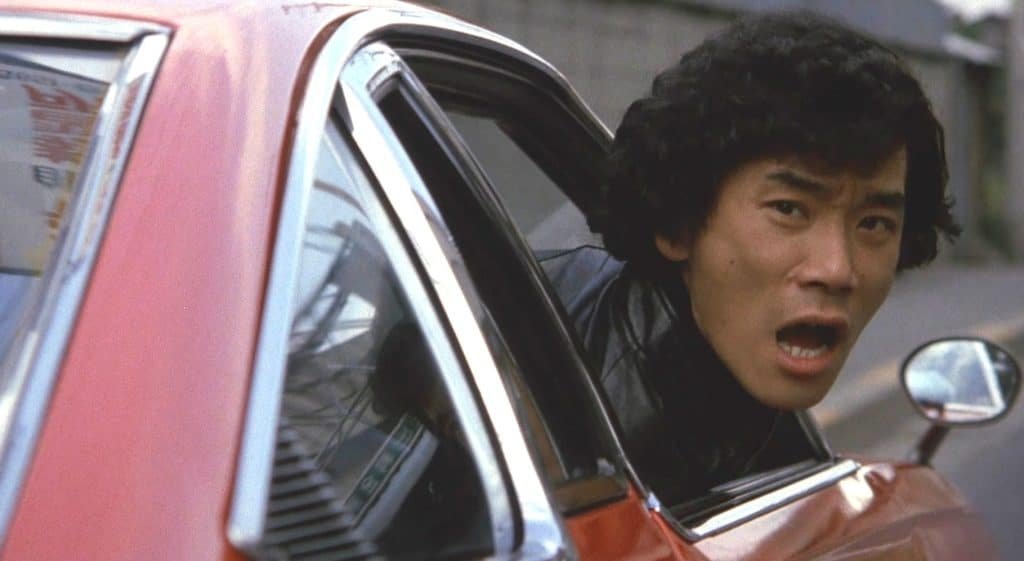
Michiyo won’t have any of it. She repeatedly runs away and eventually moves in with a yakuza. The yakuza, played by Kazuhiro Yamaji, is covered head to toe by tattoos on his backside. Takeda’s own tattoos look like child’s play compared to the yakuza’s.
Still, the yakuza is a very soft-spoken guy. He holds no grudge towards Takeda concerning Michiyo. He even passively leaves it up to Michiyo to stay with either him or Takeda.
Michiyo decides for the yakuza. Because, she tells Takeda, “He follows through on his words. Unlike you. You are just talk.”
The yakuza is clearly modelled on Kiyoshi Narumi, a small-time member of an Osaka yakuza group in competition with the most powerful syndicate, the Yamaguchi-gumi, based in Kobe.
On July 11th 1978, Narumi tried to assassinate Kazuo Taoka, the acting chief of the Yamaguchi-gumi. He shot him in his neck but Taoka survived.
In the movie, Takeda can be seen reading the news of the assassination attempt in a newspaper pinned to a wall at an Osaka train station. Only then, he really understands what Michiyo meant by saying “He follows through on his words.”
His 30th birthday drawing close, Takeda decides to actually go through with the bank robbery he had been fantasizing about.
Director Banmei Takahashi later stated that a newspaper article claiming that bank robber Akiyoshi Umekawa and yakuza assassin Kiyoshi Narumi had shared the same mistress was one of his inspirations to make the movie.
Movie Title
Though the film is known as Tattoo Ari in both English and Japanese, meaning Got a Tattoo, the title is spelled somewhat awkward in the original: TATTOO<刺青>あり. Using the English word TATTOO but then giving the Japanese translation of the word <irezumi> in the brackets.
Apparently, in 1982, the meaning of the English word “tattoo” was still not common knowledge in Japan.
The Director and the Main Actress
Director Banmei Takahashi (born in 1949) was a veteran director of pink movies (Japanese sex movies), having shot more than 40 pink films. Tattoo Ari was the film that took him out of the pink movie world and established him as a mainstream Japanese movie director.
Actress Keiko Sekine, who played the role of Michiyo in the film, was a former stage actress who later went into pink movies. The Nikkatsu Roman Porno Love Letter (1981) turned her into a movie star.
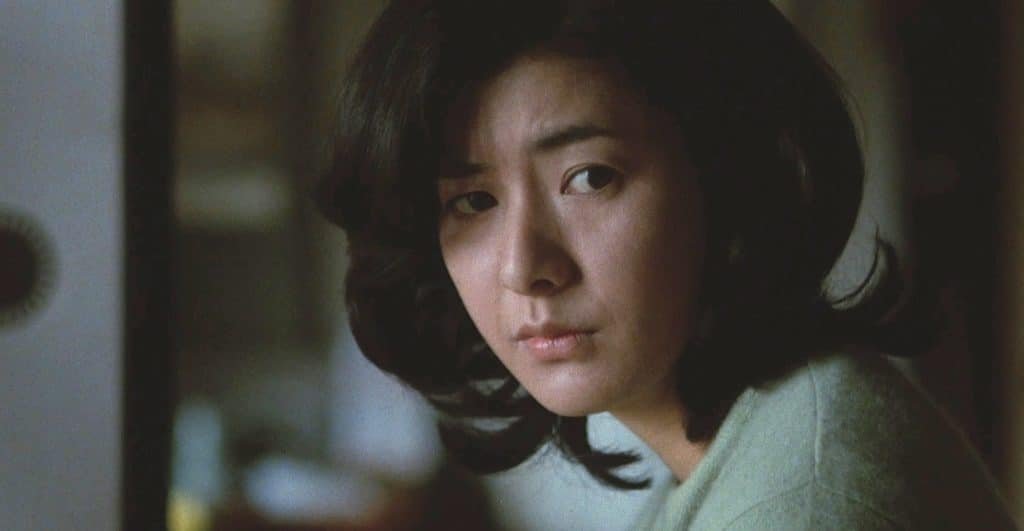
During the filming of Tattoo Ari, Banmei Takahashi and Keiko Sekine got close to each other. They married three days after the premiere of the film in June 1982. Since then, she is known as Keiko Takahashi.
Actors and Extras
Akio Takeda, the main character, is played by Ryudo Uzaki, at the time one of Japan’s leading rock stars. His band, the Down Town Boogie-Woogie Band, was one Japan’s most popular mainstream rock bands in the 1970s.
Takeda’s always worrying mother is played by Misako Watanabe, known as an actress in classic Japanese movies by directors like Shohei Imamura, Masahiro Shinoda and Masaki Kobayashi.
Director Banmei Takahashi didn’t stop there, though. He crammed the movie with pop culture personalities from beginning to end, often in brief cameos.
The tattoo artist inking the peony on Takeda? It’s Shigeru Izumiya, one of the most popular folk singers of the 1970s.
The bookstore owner selling all that hardboiled fiction and true crime books to Takeda? It’s legendary actor Yoshio Harada who played in many of the offbeat classics by the likes of Seijun Suzuki, Koji Wakamatsu and Shuji Terayama.
Film Music
Main actor Ryudo Uzaki, a rock star in his own right, composed most the songs featured in the movie. His wife, songwriter and essayist Yoko Aki wrote the lyrics.
The theme song, composed by Uzaki and lyrics by Yoko Aki, was performed by Yuya Uchiya, the legendary head of late 1960’s Flower Travellin’ Band, the band that introduced psychedelic rock to Japan. For the movie, Yuya Uchida recorded the music with his outfit Uchida Yuya and the Truman Capote Rock’n’Roll Band. Needless to say, American writer Truman Capote may have inspired the name of the band but he was certainly never a member.
Osaka Locations
This is clearly a 100% Osaka film. Even when the main character Takeda goes to visit his mother in Shikoku, she always refers to Osaka, saying, “I really hope you make it in Osaka.”
Early in the film, Michiyo and her boyfriend can be seen living in an apartment close to Tsutenkaku Tower in Shin Sekai, Naniwa Ward.
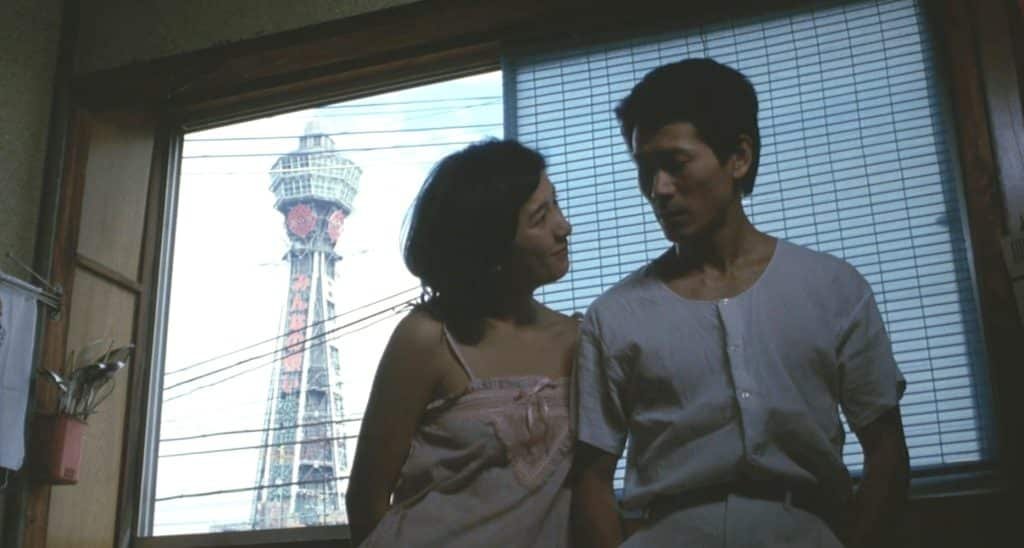
Dotonbori shows up, with the famous moving crab advertising a crab restaurant restaurant. The restaurant and its moving crab display outside still exist today.
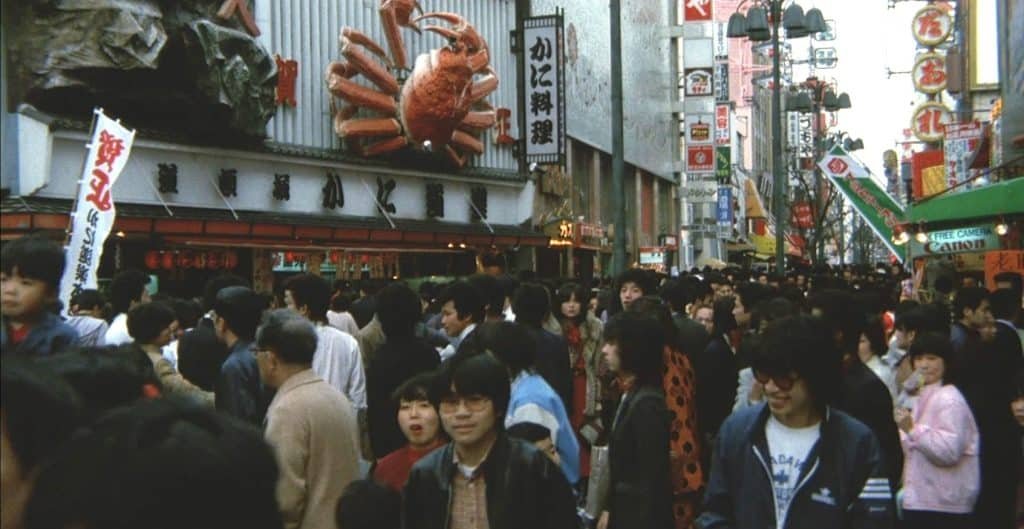
More interesting are the shots of the old Shin Kabukiza Theater. They show a location sadly gone from the Osaka cityscape.
The theater, located in Namba, existed from 1958 to 2009. Rather than featuring actual kabuki, the theater with its elegant exterior architecture was known for modern plays and performances by Japanese pop culture icons. The building was torn down in 2009.
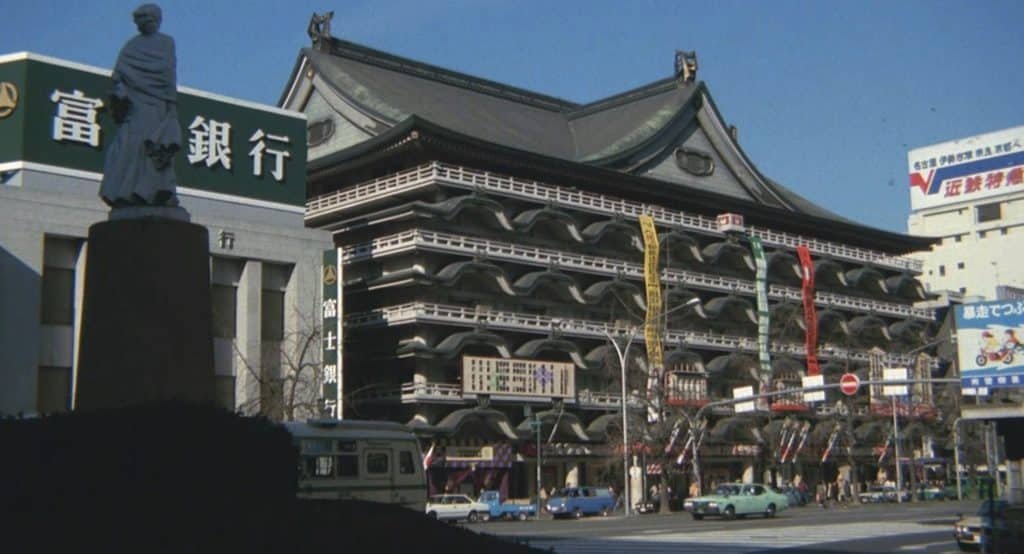
At one point in the movie, Takeda does a long drive through Namba, looking for banks to rob. Literally, there is a bank in every building along the road he drives. Bank after bank after bank.
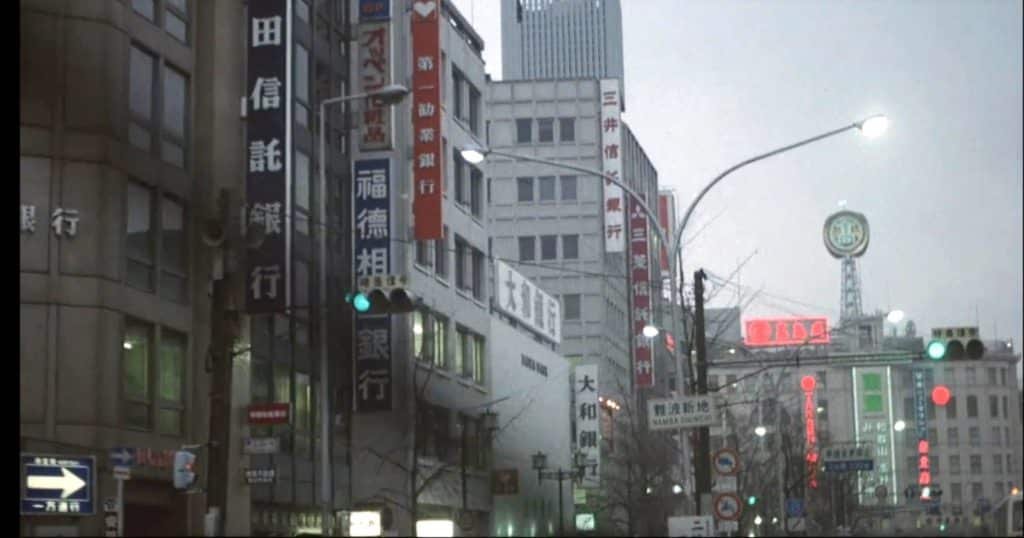
Takeda settles eventually on a fictional bank. The real Mitsubishi Bank in Sumiyoshi Ward where the actual crime took place is not featured in the movie.
Reception of the Film
At first, Nikkatsu Studio was interested in producing the film. They backed out, however. Thus, the film became an independent production distributed by the Art Theatre Guild (ATG).
Originally the film was slated to have only a very limited theatrical run in Japan. Keiko Sekine, the actress playing Michiyo however turned out to be extremely popular due to her recent appearance in the Nikkatsu produced pink movie Love Letters.
Never mind the rock stars involved with the movie, it was Keiko Sekine who brought in the audiences. Because of her, the movie became a large box office hit in Japan.
At the Yokohama Film Festival in 1983, Ryudo Uzaki was named Best Actor for his performance in the movie. Banmei Takahashi was chosen to be Best Director. The film in general won 3rd prize.
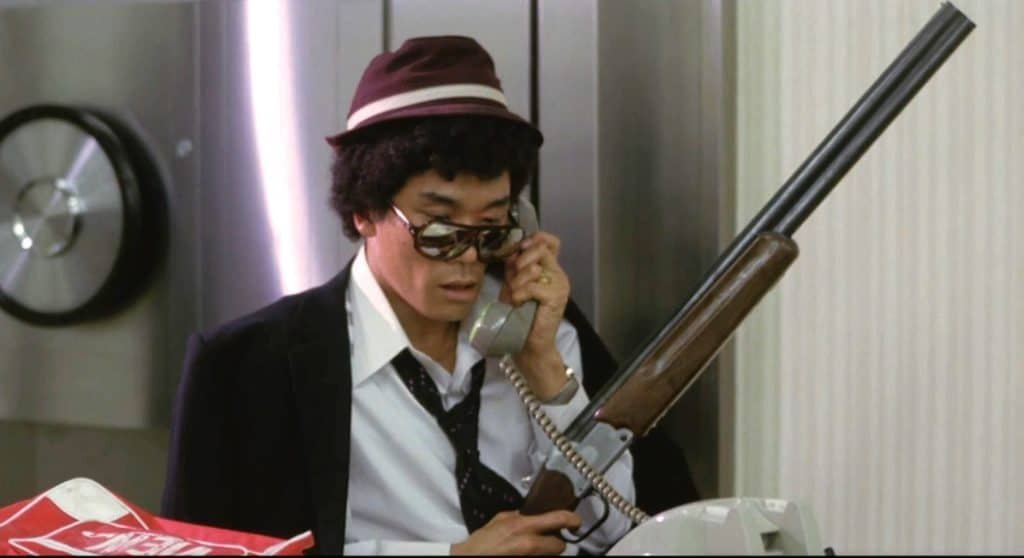
Returning to the Actual Crime Site Today
No matter the success of Banmei Takahashi’s artfully crafted movie… people in Osaka remember the actual incident in rather harsh comments on google maps…
“When I was 19 or 20 years old, there was a barricaded incident at the Kitabatake branch of Mitsubishi Bank. At that time, I was commuting from my home in Nishinari Ward to work in Hirano Ward by car, and since the site was closed to traffic, I had to make a detour. The culprit was shot dead and I felt disgusted, so I thought that the bank itself would be crushed, but it is still open. ATMs are used frequently, but there are too few of them.”

























Dear Mr. Schönherr,
My name is Gabriel Pinheiro, and I am currently pursuing a Master’s degree in Image and Sound at the Federal University of São Carlos in Brazil. I am writing to inform you of my research project, which focuses on North Korean Cinema, and to express my sincere interest in conducting an interview with you as part of this endeavor.
Your book has emerged as a pivotal reference in the development of my thesis and having the opportunity to discuss your insights and perspectives would be a tremendous honor for me.
I kindly request the privilege of your time for an interview. I have provided my email address below for your convenience, and I would greatly appreciate it if you could reach out to me at your earliest convenience to arrange a suitable time for our discussion.
Email: gabrielpinheirobsb@gmail.com
Warm regards,
Gabriel Pinheiro